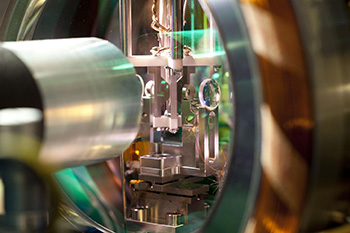
The experimental apparatus in which the researchers demonstrate a quantum interface. Credit: IQOQI/Lackner
Researchers from the University of Innsbruck, Austria, have improved their design for an ion-trap interface that could one day serve as a link between quantum processors and fiber optic communication channels (Phys. Rev. Lett., doi: 10.1103/PhysRevLett.114.023602). The enhanced interface can generate photons almost twice as fast as the previous design and has read-write capabilities for storing and retrieving quantum information.
Unlike their original design, the new ion-trap interface takes quantum information stored in a pair of entangled calcium ions—rather than a single ion—and maps it onto a photon. The new interface works by trapping the two ions between two highly reflective mirrors, forming an optical resonator. The interaction between the particles in the resonator can be tuned with a laser to a maximally entangled state, creating enhanced single photons much faster than in their previous experiments. According to lead author Bernardo Casabone, this superradiant state makes information transfer from the ion pair to the photon more robust and eases technical requirements for interface manufacturing.
The researchers were also able to generate subradiant states in the ion-cavity system. To create a subradiant state, they tuned the optical resonator to suppress the photon emission, making the information stored on the ions “invisible.” By adjusting the phase from sub- to superradiant, quantum information can be retrieved from the ions as photons. This read-write capability—selectively turning off and on the coupling of logical qubits in the cavity—would be a useful tool for operations in a quantum register.
